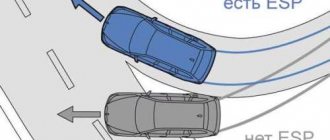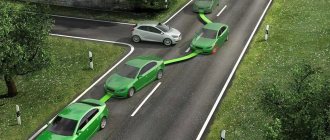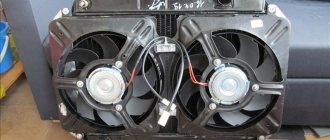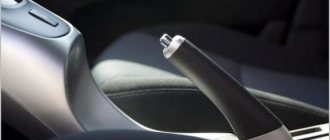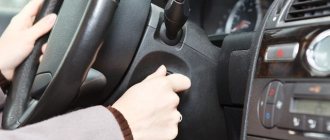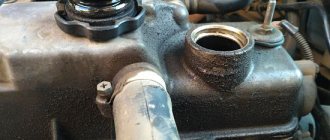The ESC exchange rate stability system is an electro-hydraulic active safety system, the main purpose of which is to prevent the car from skidding, that is, to prevent deviation from the specified trajectory during sharp maneuvering. ESC has another name - “dynamic stabilization system”. The abbreviation ESC stands for Electronic Stability Control - electronic stability control (ECU). The stabilization system is a comprehensive system that covers the capabilities of ABS and TCS. Let's consider the principle of operation of the system, its main components, as well as the positive and negative aspects of operation.
How the system works
Let's look at the principle of ESC operation using the example of the ESP (Electronic Stability Program) stability control system from Bosch, which has been installed on cars since 1995.
ESC stabilizes the car's position when skidding
The most important thing for ESP is to correctly determine the moment of an uncontrollable (emergency) situation. While driving, the stabilization system continuously compares the vehicle's movement parameters and the driver's actions. The system begins to work if the actions of the person behind the wheel become different from the actual parameters of the car’s movement. For example, a sharp turn of the steering wheel at a large angle.
An active safety system can stabilize a vehicle's motion in several ways:
- braking certain wheels;
- changing engine torque;
- changing the angle of rotation of the front wheels (if an active steering system is installed);
- changing the degree of damping of the shock absorbers (if adaptive suspension is installed).
The exchange rate stability system prevents the car from going beyond the specified turning path. If the sensors detect understeer, ESP brakes the rear inner wheel and also changes the engine torque. If oversteer is detected, the system brakes the front outer wheel and also varies the torque.
To brake the wheels, ESP uses the ABS system on which it is based. The work cycle includes three stages: increasing pressure, maintaining pressure, releasing pressure in the brake system.
The engine torque is changed by the dynamic stabilization system in the following ways:
- canceling gear changes in an automatic gearbox;
- missed fuel injection;
- changing the ignition timing;
- changing the throttle position angle;
- misfire;
- redistribution of torque along the axles (on vehicles with all-wheel drive).
Is electronic stability control necessary?
Data and statistics support the benefits of having ESC in vehicles and preventing accidents. Active safety technology such as ESC, according to Road Safety Fact.eu, "can prevent accidents entirely, or at least actively help the driver reduce the impact of an emergency situation" .
One regularly cited study from Loughborough University shows that the risk of being involved in an accident has decreased by 25%. Other research suggests that ESC is more effective in reducing some types of multiple crashes.
Device and main components
The exchange rate stability system is a collection of simpler systems: ABS (prevents brake locking), EBD (distributes braking forces), EDS (electronically locks the differential), TCS (prevents wheel slip).
Components of the exchange rate stability system: 1 – hydraulic unit with ECU; 2 – wheel speed sensors; 3 – steering angle sensor; 4 – linear and angular acceleration sensor; 5 – electronic engine control unit
The dynamic stabilization system includes a set of sensors, an electronic control unit (ECU) and an actuator - a hydraulic unit.
Sensors monitor certain vehicle movement parameters and transmit them to the control unit. Using sensors, ESC evaluates the actions of the person behind the wheel, as well as the driving parameters of the car.
To evaluate the actions of a person behind the wheel, the stability control system uses brake pressure and steering angle sensors, as well as a brake light switch. Vehicle movement parameters are monitored by sensors of pressure in the brake system, wheel speed, angular velocity of the vehicle, longitudinal and lateral acceleration.
Based on the data received from the sensors, the control unit generates control signals for the actuators of the systems that are part of the ESC. Commands from the ECU receive:
- anti-lock braking system intake and exhaust valves;
- high pressure valves and traction control switching valves;
- ABS, ESP and brake system warning lamps.
During operation, the ECU interacts with the automatic transmission control unit, as well as with the engine control unit. The control unit not only receives signals from these systems, but also generates control actions for their elements.
Pros and cons of ESP and ESC
Like any system aimed at improving something, the exchange rate stability system has its advantages and disadvantages.
The main advantages are:
- Makes it possible to maintain vehicle stability and move within a given trajectory;
- Maintaining vehicle controllability in bad weather conditions and preventing the vehicle from tipping over;
- Vehicle collision prevention;
- Greater controllability, maneuverability and flexibility of the car on the road and stabilization of the road train;
- Creates a third driver-controlled dimension.
The system prevents enough skidding, which is a major factor in serious accidents and accidents resulting in death or irreparable harm to health.
The disadvantages include:
- The system can be turned off, which is used by extreme drivers.
- The system can show extremely poor performance at high speeds and at small turning radii.
Disabling the ESC system
ESC disable button
If the dynamic stabilization system “interferes” with the driver when driving the car, it can be turned off. Usually there is a special button on the dashboard for these purposes. It is recommended to disable ESC in the following cases:
- when using a small spare wheel (dokatka);
- when using wheels of different diameters;
- when driving on grass, patchy ice, off-road, sand;
- when driving with snow chains;
- while rocking a car that is stuck in snow/mud;
- when testing a machine on a dynamic stand.
History [edit | edit code]
Electronic stability control systems, similar in principle to modern automobile ones, first appeared in the 1960s in aviation, where they ensured the stability of the aircraft while running along the runway during landing or aborted takeoff. The Anglo-French supersonic airliner Concorde was one of the first to receive such a system due to its high landing speed and high center of mass position.
In 1987, Mercedes-Benz and BMW introduced the first traction control systems (traction control systems).
In 1990, Mitsubishi launched the Diamante (Sigma) in Japan, equipped with a new active electronic traction and stability control system, where the two systems were integrated into one for the first time (called TCL).
BMW, together with Robert Bosch GmbH and Continental Automotive Systems, developed a system that reduces the torque transmitted by the engine to the wheel to prevent skidding and applied it to the 1992 BMW model range. From 1987 to 1992, Mercedes-Benz and Robert Bosch GmbH jointly developed the vehicle's electronic stability control system and called it the "Elektronisches Stabilitätsprogramm" (ESP).
History of the Mercedes-Benz A-Class [edit | edit code ]
The ESC system was created in 1995, but it managed to make itself known only two years later, when the first compact Mercedes-Benz A-Class debuted. During its design, serious mistakes were made, which led to the fact that the new model had a tendency to tip over even at not very high speeds when performing maneuvers such as “rearrangement” (“moose” test, avoiding an obstacle).
A scandal broke out in Europe; sales of Mercedes-Benz A-class cars were suspended, and cars already sold were recalled to eliminate deficiencies. The company's engineers were faced with a problem: how to solve the problem of increasing stability without redesigning the car and maintaining its consumer qualities. This task was solved to a large extent by the installation of a suitably configured ESC system since February 1998.
The main ESC controller is two microprocessors, each with 56 KB of memory. The system allows you to read and process values produced by wheel speed sensors with a 20-millisecond interval. In addition to the A-Class, the ESP system is standard equipment on the Mercedes S-Class, E-Class and others. Daimler-Chrysler vehicles use ESC systems from the leader in this field, Bosch. Bosch ESC systems are also used by Alfa-Romeo, BMW, Volkswagen, Audi, Porsche and others.
In fact, it was the case of the Mercedes-Benz A-Class that paved the way for the widespread introduction of electronic stability control on European cars.
Application
In Canada, the USA and the countries of the European Union, since 2011, stability control systems have been mandatory installed on all passenger cars. Note that system names vary depending on the manufacturer. The abbreviation ESC is used on Kia, Hyundai, Honda cars; ESP (Electronic Stability Program) - on many cars in Europe and the USA; VSC (Vehicle Stability Control) on Toyota cars; DSC (Dynamic Stability Control) system on Land Rover, BMW, Jaguar cars.
The dynamic stabilization system is an excellent assistant on the road, especially for inexperienced drivers. Do not forget that the possibilities of electronics are also not limitless. The system in many cases significantly reduces the likelihood of an accident, but the driver should never let down his guard.
What are the benefits of electronic stability control?
Many studies have been conducted to determine the effectiveness of the stability control system.
According to the European Road Safety Observatory (ERSO), vehicles with ESC:
- 22% less likely to get into an accident.
- You are up to 38% less likely to be involved in an accident due to wet or snowy roads.
- The likelihood of rollover is reduced by 59% - and this is more than 67% for SUVs.
- 33% less likely to skid.
Due to its high efficiency and benefits for drivers, the European New Car Assessment Program (Euro NCAP) added ESC to its safety tests in 2009.
This means that vehicles not equipped with ESC cannot achieve the highest 5-star safety rating.
Distribution[edit | edit code ]
While Sweden is conducting public awareness campaigns and promoting the use of ESC systems, other countries are legislating for their use.
Mandatory equipping of cars with an electronic stability system is introduced with:
- On January 1, 2010, it became mandatory in Israel. [1]
- September 1, 2011 in Canada, for all new passenger vehicles.
- 1 November 2011 in Australia, for all passenger vehicles.
- from November 2011 in the European Union, for all vehicles sold.
- since 2011 in the USA, for all passenger vehicles weighing less than 4,536 kg (10,000 lb).
Read also: Peugeot 308 engine cooling diagram
Extra stability when turning with ESC
Since ESP provides additional safety along with ABS and TCS, it may not surprise you to learn that it uses much of the hardware from those systems to operate. Using sensors to measure the speed of individual wheels, as well as information from the lateral acceleration sensors and lateral speed sensors, the ESP control unit constantly monitors the vehicle's lateral movements and compares them with the position of the steering wheel. If the car does not respond to the steering wheel as programmed, or the specified steering angle and speed are too high, ESP will begin to brake the wheels in an attempt to maintain a straight trajectory. In this case, braking is carried out with active interaction with ABS, which eliminates the blocking of one of the wheels. The very essence of the operation of the system in question is to begin to actively assist in the process of driving the car even before the driver realizes that he is beginning to lose control.
The system works constantly, regardless of the driving mode, and even when coasting. And the mechanism of its influence completely depends on the situation and design features of the car. For example, if the rear axle begins to slip during a sharp turn, the electronics begins to smoothly reduce the amount of fuel supplied to the engine, ensuring a decrease in its speed. If this is not enough, then a gradual braking of the front wheels begins. If the car is equipped with an automatic transmission, then ESP allows you to forcibly activate the winter operating mode, providing the ability to switch to a lower gear.
Adding a third safety element to ABS and traction control
In order for your car to be equipped with ESP, it must be equipped with ABS (Anti-lock Braking System) and TCS (Traction Control System). In their simplest form, these two active safety elements are designed to improve handling and predictability, and also maintain control over the car when braking and accelerating, respectively, so their intervention in the control process is reduced only to controlling linear acceleration.
Read also: Navigation Nissan Qashqai 2007
ESP complements them and introduces a third controlled dimension, since it is responsible for moving the car in a direction perpendicular to the trajectory of movement, in which phenomena such as understeer or oversteer - skidding - occur. In more advanced versions, it is in constant interaction with the electronic engine control unit in order to maximize its efficiency.
According to statistics, ESP can prevent up to 80% of skids, which is an excellent indicator, especially given the fact that about 40% of accidents occur precisely because of this phenomenon. However, it is worth remembering the words of Scotty from the movie Star Trek: “You can change the laws of physics!” Of course, the possibilities of active safety systems are not unlimited and this should not be forgotten. If the driver crosses the point where loss of control over the car is inevitable, none of the currently existing systems will prevent serious consequences.
